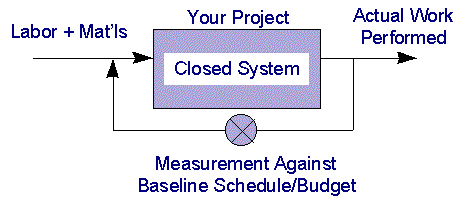
The Project Management Triangle
Project management control can only be achieved when cost, schedule, and technical objectives are clearly documented, realistically derived, and managed deliberately.

The planning process should result in major parties to the project having a clear sense of the cost, schedule, and technical objectives. The establishment of these three should attempt to define the possible. The project’s technical objectives should be derived from a clear understanding of the business requirements. Project costs should be realistic and affordable. The schedule should be achievable and appropriate for the business needs.
Trade-off studies balancing technical performance, schedule, and costs may be used to adjust project parameters to fit with organizational priorities. The realism inherent in determining these three project parameters can largely effect the perceived success or failure of the project.
Efforts to accelerate project schedules will usually increase project risks. Innovative techniques must be used to achieve orderly schedule compression without creating unacceptable risks and quality impacts.
Without reducing project scope or attempting radical development methodologies, a project schedule can often be compressed by up to 20% by increasing concurrency of tasks and adding additional staffing. A typical project environment will usually involve pressures to add scope, accelerate schedule, and decrease costs. Nevertheless, changes to project scope and schedule accelerations will tend to make cost the dependent variable, causing cost to expand as if one were squeezing a balloon.
Planning and Establishing the Project Baseline
An Iterative Process
Begin Here:

Project baseline definition begins with understanding the user or customer requirements. Understanding requirements involves making judgments about what the organization, technologies, and markets will be like in the time-frame after project completion. Sometimes a requirements analysis will have to penetrate beyond a mere synthesis of what user’s think they need. The project requirement may be part of a larger need to improve vital business processes.
After the requirements analysis has resulted in definition of the project’s technical scope, the cost and schedule estimates can be refined. Project costs and schedules can be estimated with no greater certainty than that inherent in the definition of technical scope. Cost and schedule estimates will require assumptions about labor categories, availabilities, and rates - knowing who will do the work - so assumptions and commitments about organizational involvements are needed. When cost, schedule, and requirements definition are acceptable to the organization, a project planning baseline must be established.
Very often, establishing the project baseline will be an iterative process involving a number of successive approximations before a baseline is established. The first pass may result in a project that is too costly and will take too long. This can happen if the requirements analysis is done well. If the requirements analysis is done incompletely, the project plan may look affordable and achievable, but further emerging requirements may drive the project over budget and prolong the schedule.
A rigorous requirements analysis and a realistic cost and schedule estimate are necessary to establish a project baseline plan that provides a practical map for project success.
Manage Your Project as a Closed-System
The only way to really control a project is to treat it as a closed system. That means you put the project "in a box" and then control what goes into the box and what comes out. The closed system must address each element of the project management triangle. Each element must be established as a BASELINE, and then changes tracked and managed methodically. You will never be able to stop changes on a project, but if you don't manage them methodically, your project will go out of control. Don't be surprised if establishing and maintaining control of the schedule, cost, and scope baselines is a continual struggle.

Most project environments are so turbulent that you will have to work hard to control the project as a closed system. This means you need to manage the scope, cost, and schedule in such a way that you understand and can generally quantify anything that changes as the project progresses. The primary way to do this is by various forms of "baseline controls."
The project scope needs to be defined clearly in a scope document or specification, and then any changes to that document need to be incorporated into the project plan very carefully. The cost estimates, project budgets, and project schedule (with associated commitments of work hours and resources) need to be baselined in order to have a useful standard against which to measure.
You need to be able to measure the work that goes into a project in dollars and work hours and the productivity that comes out of the project, in percent completions and tasks accomplished. Without a stable baseline and measurement of input and output, the project cannot be measureable and in control.
On modest sized projects and in informal project management environments you will need to develop innovative ways to set up a performance measurement baseline and keep that baseline stable enough to be able to track project progress. In some cases, scope changes will be small enough so your baseline can still be useful for project tracking. For larger changes in project scope, the baseline will have to be updated. This is a judgment call for the project manager and for those involved with the project control function. You just need to have a sense that your baseline is useful for tracking schedule progress and for measuring project team productivity.